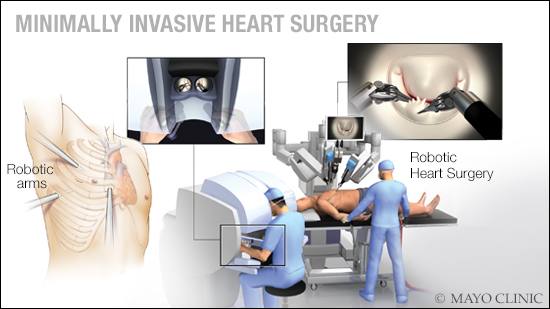-
Mayo Clinic Q and A: Mitral valve repair with minimally invasive heart surgery

DEAR MAYO CLINIC: Is minimally invasive heart surgery to repair a mitral valve a safer option than open-heart surgery? Is it common for a surgeon to have to switch to an open-heart procedure after starting the surgery?
ANSWER: Both minimally invasive heart surgery and traditional surgery that involves opening the chest bone — a procedure known as sternotomy — are safe, effective ways to repair a damaged mitral valve. The minimally invasive approach requires less recovery time, and the risk of complications is lower with that procedure. Because patients are screened thoroughly prior to surgery to ensure they are good candidates for the minimally invasive approach, it’s rare for surgery to be changed while it’s in progress.
The mitral valve is in the left side of the heart — the side that receives oxygen-rich blood from the lungs and pumps it to the rest of the body. Located between the upper left chamber (left atrium) and the lower left chamber (left ventricle), the mitral valve has flaps that open and close once during each heartbeat to allow blood to pass through it.
The mitral valve may need to be repaired for a number of reasons. One of the most common is a condition called myxomatous degenerative mitral valve disease. In people who have this condition, the valve flaps get floppy, and the strings that support the flaps become elongated and may eventually break. When that happens, the valve can’t close securely, and it allows blood to flow backward into the left atrium toward the lungs.
A damaged mitral valve often can be repaired, and it’s common for mitral valve repair to be performed using a minimally invasive approach, rather than with a sternotomy incision. Both approaches are still considered open-heart surgery and require use of the heart-lung machine.
During minimally invasive surgery, the surgeon makes several tiny incisions between the ribs to gain access to the heart. Then surgical instruments and a small, high-quality camera are inserted through those holes. The surgical tools are connected to robotic arms that the surgeon controls with a computerized device.
Because the surgical instruments are so small, and the surgeon can see their movement in great detail on a computer monitor, he or she can make extremely precise movements with those instruments. That allows the surgeon to perform the procedure with less manipulation and trauma to the heart and chest wall than is possible with a sternotomy.
Sternotomy typically requires about six days in the hospital, and six to eight weeks of recovery. For the minimally invasive procedure, the hospital stay is about three to four days, and full recovery usually takes about three to four weeks. The risk for complications — such as infection and excess blood loss — is lower, and patients generally have less pain following minimally invasive heart surgery.
It’s quite rare for a surgeon to switch from the minimally invasive approach to a sternotomy during a mitral valve repair. But the operating team is prepared to do so in the event of an emergency.
To reduce the likelihood that the procedure will need to be converted to the larger incision while surgery is in progress, patients are evaluated carefully to confirm that the minimally invasive approach is the best option. For example, patients who have chest wall deformities may not be good candidates for minimally invasive surgery because there might not be enough space in the chest cavity to maneuver the instruments. Some underlying medical problems, such as vascular disease or lung disease, can make minimally invasive surgery difficult, as well. In those cases, the surgeon would opt to use a sternotomy, which also has excellent results.
Regardless of the approach, minimally invasive or traditional sternotomy, the technique used to repair the mitral valve is the same with both types of incisions, and that gold-standard technique has proven to be effective. — Dr. Joseph Dearani, Cardiovascular Surgery, Mayo Clinic, Rochester, Minnesota
****************************
Related Articles
- The benefits of minimally invasive and robotic heart surgery: Mayo Clinic Radio published 9/9/19
- Mitral valve repair and mitral valve replacement published 2/28/19
- Structural heart disease / hip arthroscopy / avoiding infection during manicures and pedicures: Mayo Clinic Radio published 2/24/19







